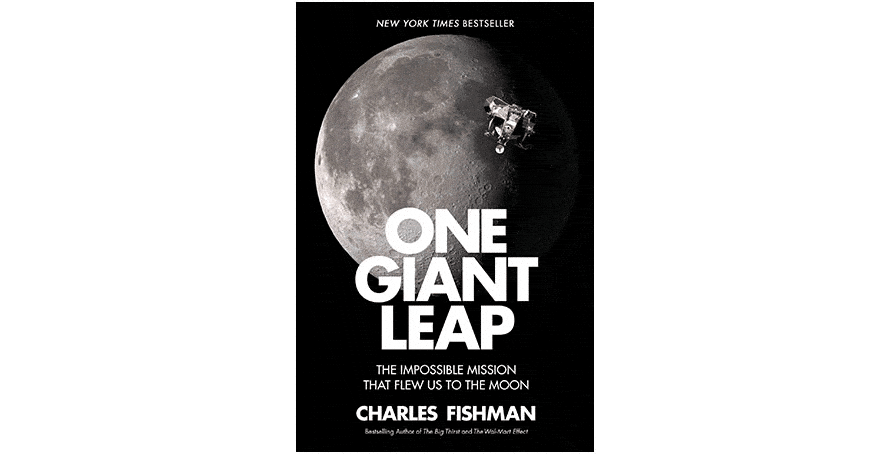Category: Nonfiction
Reviewed by: Robert A. Lee
Title: One Giant Leap: The Impossible Mission That Flew Us to the Moon
Author: Charles Fishman
NSS Amazon link for this book
Format: Hardcover/Paperback/Kindle/AudioCD
Pages: 480
Publisher: Simon & Schuster
Date: June 2019
Retail Price: $29.99 Hardcover/$14.99 Kindle
ISBN: 978-1501106293
I have read much about the Apollo program and still learned new and interesting facts in this book.
Charles Fishman, an award-winning business journalist and New York Times bestselling author, recounts the story of the many men and women tasked with putting a man on the Moon. This effort of approximately 400,000 people equated to 1 million hours of labor for every hour of Apollo spaceflight, or 10 lifetimes of work back on Earth. And much of this critical work was accomplished at a time when “every question of how to fly to the Moon was unanswered.” As NASA prepares to return astronauts to the Moon within the next decade (this time to stay), and the 50th anniversary of that first landing approaches, this book acts as a reminder about what is required to achieve epic results.
The book starts with a look back to the 1950s, when home appliances such as dishwashers, clothes dryers, and air-conditioning were the latest “technology.” Alan Shepard, in America’s first short 15-minute flight, was so busy flipping switches, checking equipment status, and operating control jets, he only noticed he was weightless when a loose washer floated past. How would men control a spacecraft traveling seven miles per second in an age when transistor radios were brand new? NASA would need to leap-frog us into the digital age.
The next chapter jumps ahead to a story familiar to many: Neil Armstrong and Buzz Aldrin flying the Eagle to the Moon’s surface while avoiding a boulder field, with fuel running low and their compact computer spitting out warning alarms. The author takes the next section of the book to describe the design of the Lunar Module’s (LM’s) one cubic foot computer, which was a bit heavier than an astronaut and a blend of cutting-edge science, technology and art. Along the way, he documents the computer’s many creators and their crucial decisions that helped save that first Moon landing.
A key early player was Charles “Doc” Draper at MIT who pioneered inertial navigation. His MIT Instrumentation Lab would move 100 people from their Polaris missile work to designing the Apollo and LM computers and writing the complicated math and software. Due to size and weight restrictions, these computers would use integrated circuit chips instead of transistors, in spite of IC chips having just been invented. One single IC chip was used for everything, made by one manufacturer (Fairchild, and later PhilCo), and tested relentlessly for quality. MIT purchased one million of them and forced new levels of quality mass-production since their reliability had to be “safer than a parachute.”
In perhaps the most astonishing design decision, the computer software was “loaded” into the computers by women at Raytheon using 8-inch long needles. They stitched long wires either through or outside miniscule circular ring magnets for ones and zeros, all done 8 to 12 weeks before a launch. It became known as LOL memory for “little old ladies.” This core LOL memory design was almost indestructible—impervious to stray radiation and even lightning strikes as demonstrated during Apollo 12’s launch.
Bill Tindall at NASA forced key decisions to make the code fit into 36K words of memory. Hal Laning created the idea of the computer prioritizing every subroutine and task so it would perform the most critical functions first. And Charley Muntz designed a restart capability, so the computer could instantly restart itself if interrupted and continue where it left off. The author then describes how these design decisions saved the first landing and states, “one thing is certain: any other computer, at that moment in that era, would have choked.”
An interesting section of the book discusses the secret John F. Kennedy tapes which only came to light after Nixon’s secret tapings were revealed. In the later meetings between JFK and NASA chief James Webb, Kennedy begins to backpedal from his support of the space program when a successful Moon landing would happen after his second administration. He would experience huge budgets without a payoff, and already media headlines were shouting “Billions wasted in Space” and “Moon Madness.” These sentiments can still be heard today.
In the chapter entitled, “America almost forgets to take a flag to the Moon,” readers learn how John Kitzler at Houston came up with the idea for a flag ceremony only a few months before the landing, and design engineer Thomas Moser ensured that the flag, attached to the LM’s ladder, would not destroy the ladder during a critical thirteen seconds of 2000 degree Fahrenheit engine burn. The flag, which required 27 documented steps to fold, pack and attach, was placed on the LM exactly one day before launch.
The final section of the book argues that perhaps the most lasting legacy of the Apollo program was accelerating America into the digital age. The vast majority of IC chips, built by American companies and which would become a staple of later digital devices, were purchased by NASA which demanded perfection in quality and performance.
In this book NSS members should find a good review of the Apollo program and be reminded of the hard work behind achieving great dreams. And that dream of outer space is still alive. After all, as the author states, the Air & Space Museum is the most visited museum anywhere in the world.
© 2019 Robert A. Lee
Please use the NSS Amazon Link for all your book and other purchases. It helps NSS and does not cost you a cent! Bookmark this link for ALL your Amazon shopping!




















1 thought on “Book Review: One Giant Leap”
Really good review. I get a good taste of the book. Entices me to read it. Would would have guessed? More government tapes.